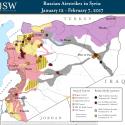 |
 |
Russian Airstrikes in Syria: January 12 - February 7, 2017

Russia resumed its aggressive air campaign in northern Syria in a renewed attempt to defeat the acceptable opposition and coerce the integration of its remaining fighters into Salafi-jihadi groups, demonstrating its unfitness to serve as a U.S. counter-terrorism partner. Russia conducted airstrikes against ISIS in Deir ez Zour City and its environs in eastern Syria from January 26 – 31 and February 3 – 6, vying to blunt the jihadist group’s ongoing offensive against pro-regime forces in the besieged Deir ez Zour Military Airport. Russia nonetheless belied its alleged commitment to the anti-ISIS fight by deliberately targeting acceptable opposition forces during this period, aiming to enhance the Salafi-jihadi makeup of the opposition and thereby bolster the purported counter-terrorism mandate of the pro-regime alliance. In pursuit of that objective, Russian warplanes targeted opposition terrain behind front lines in northern Hama, western Aleppo, and southern Idlib Provinces from January 26 – February 7, resuming air operations in those areas just two days after the conclusion of Russia-sponsored peace negotiations on the Syrian Civil War in Astana, Kazakhstan. Notably, Russia repeatedly targeted current and former U.S.-backed opposition forces during the course of those operations. Russia, for instance, conducted airstrikes against a Jaysh al Mujahideen headquarters in western Aleppo Province on January 19 and a Jaysh al Aza headquarters in northern Hama Province on January 29, continuing its campaign to eliminate U.S. ground partners in Syria. Likely by design, such strikes have rendered the targeted groups increasingly vulnerable to the attacks of al Qaeda affiliate Jabhat Fatah al Sham as it also works to defeat the acceptable opposition. Russia also delivered a shipment of fifty SS-21 ‘Scarab’ short-range ballistic missiles to the Port of Tartus in western Syria on or around February 6, firing at least two ‘Scarab’ and four SS-26 ‘Iskander’ ballistic missiles against opposition terrain in Idlib Province over the next forty-eight hours, according to anonymous U.S. officials. This missile capability will likely advance the deliberate targeting campaign against the acceptable opposition, which will continue until Russia dismantles these groups and compels their remnants to cooperate more closely with Salafi-jihadi forces out of military necessity. In the process, Russia will in effect enhance a Salafi-jihadi threat in Syria that it has little intent to counter.
The following graphic depicts ISW’s assessment of Russian airstrike locations based on reports from local Syrian activist networks, statements by Russian and Western officials, and documentation of Russian airstrikes through social media. This map represents locations targeted by Russia’s air campaign, rather than the number of individual strikes or sorties. The graphic likely under-represents the extent of the locations targeted in Eastern Syria, owing to a relative lack of activist reporting from that region.
High-Confidence Reporting. ISW places high confidence in reports corroborated by documentation from opposition factions and activist networks on the ground in Syria deemed to be credible that demonstrate a number of key indicators of Russian airstrikes.
Low-Confidence Reporting. ISW places low confidence in reports corroborated only by multiple secondary sources, including from local Syrian activist networks deemed credible or Syrian state-run media.
By Jonathan Mautner